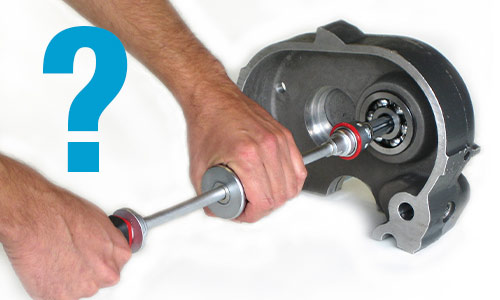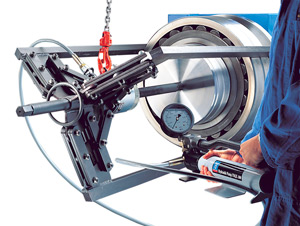What type of bearing puller should I use?

Choosing the right bearing puller for dismounting bearings is critical and selecting the correct puller is key to ensuring safe and easy removal.
In this article, we’ll explain the types of bearing pullers available and how to decide which one is right for your application.
What is a bearing puller?
 A bearing puller is a tool which is used to remove components such as bearings, gears and pulleys from a shaft or a recess. The puller securely grips the component with specially designed jaws before driving it off the shaft.
A bearing puller is a tool which is used to remove components such as bearings, gears and pulleys from a shaft or a recess. The puller securely grips the component with specially designed jaws before driving it off the shaft.
Pullers are used in every industry for safely and effectively dismounting bearings. Whether you’re working in the automotive industry or the food and beverage industry, a bearing pulley could facilitate easy dismounting of your bearings and other components.
Why use a bearing puller?
Pullers are one of the most effective methods of cold dismounting. When a component is securely mounted and cannot be loosened manually, that’s where a bearing pullers come in.
This could include situations where a damaged part has led to machine breakdown. The failed component must be removed as quickly and as safely as possible in order to keep downtime to a minimum.
If you don’t have any specialist tools around, it could be tempting to use a hammer and brute force to remove the bearing. However, this can lead to surrounding components becoming damaged, causing further downtime.
A bearing puller can efficiently remove the stuck component from the shaft or recess, without causing any damage to the shaft or other surrounding components. This helps to promote the uptime and reliability of your machinery.
Bearing pullers also offer a safe method of removal when compared to techniques such as brute force or naked flames. Leading manufacturers such as SKF have optimised puller design to ensure that they enable maximum worker safety. After all, no business wants to see their staff injured.
Bearing puller types

Every bearing puller falls into the broad categories of either an external bearing puller and an internal bearing puller.
External bearing pullers are used when the bearing is mounted onto a shaft. They have jaws which grip the outer diameter of the bearing, along with a forcing screw which pushes against the end of the shaft. As the forcing screw is tightened, the jaws force the bearing along the shaft.

This type of puller can be either mechanical or hydraulically-assisted. A Hydraulic Bearing Puller requires minimal manual effort, making them ideal for heavy-duty applications. However, specialist heavy-duty bearing pullers are also available for these applications.
Internal or blind bearing pullers are used where the bearing or component is fitted within a recess, with an opening in the inner diameter. The puller is inserted into the inner diameter of the bearing where it grips the bearing. This can be through expansion or using claws. The bearing can then be pulled from the recess.
Reversible bearing pullers are also available. This type of pullers is suitable for both internal and external pulling, thanks to their reversible arms. This makes them ideal for use in applications where there are bearings fitted both on shafts and in recesses.
How to decide what type of puller to use
The decision of which puller to use is dependent on many factors. You’ll first need to establish whether you need an external or an internal bearing puller.
If the component that you’re removing is seated on a shaft and is freely accessibly from the outer diameter, you’ll need an external bearing puller. This is the most common type of puller. However, if the part you’re trying to remove is in a recess with the inner diameter accessible, you’ll need an internal bearing puller.
 If you require an external bearing puller, you’ll then be able to choose between mechanical and hydraulic bearing pullers. If you’re on a tight budget, a mechanical bearing puller may be suitable. However, if you’re working with heavy-duty machinery, you might consider a hydraulically-assisted bearing puller to reduce the manual effort required.
If you require an external bearing puller, you’ll then be able to choose between mechanical and hydraulic bearing pullers. If you’re on a tight budget, a mechanical bearing puller may be suitable. However, if you’re working with heavy-duty machinery, you might consider a hydraulically-assisted bearing puller to reduce the manual effort required.
You’ll also need to consider the space conditions. This includes the diameter and depth of the bearing, along with the available space around the bearing. Some bearing pullers will require more space to operate than others.
The choice of which bearing puller to use should always be made after careful consideration of all influencing factors. If you’re unsure which bearing puller to choose, it’s best to consult an expert before making your decision.
Buying a bearing puller
When you need a bearing puller on a short lead time, it can be tempting to type ‘buy bearing puller online’ into Google and click on the first option that appears. However, you need to be certain that you’re purchasing the right bearing puller for your needs, as well as a genuine and reliable tool.
At ACORN, we offer same day availability on our stocked range of pullers. Our authorised distributorship status means that many more options are available on a next-day basis. So whatever your requirements, we can source a genuine and reliable part quickly.
If you need help, our team are on hand to find the right bearing puller for your application.
